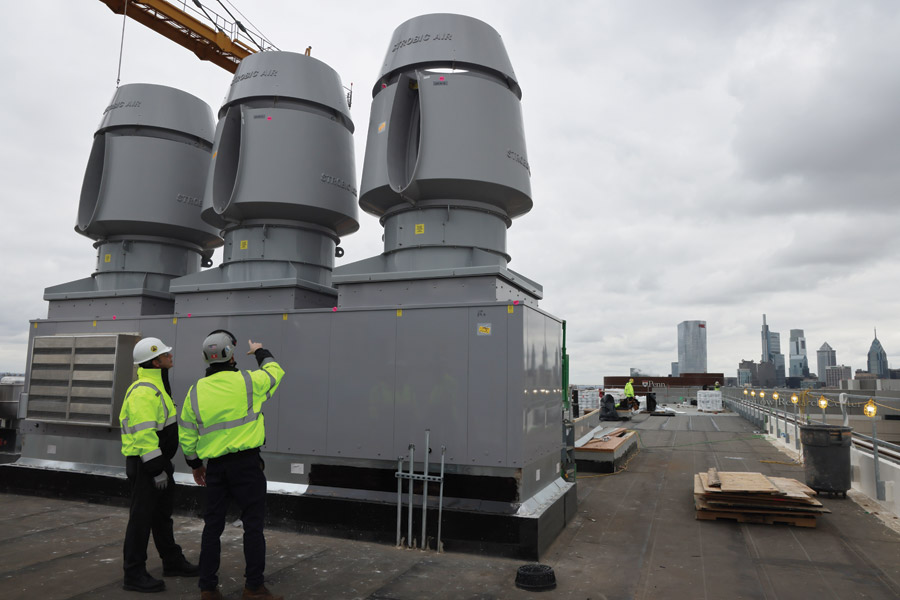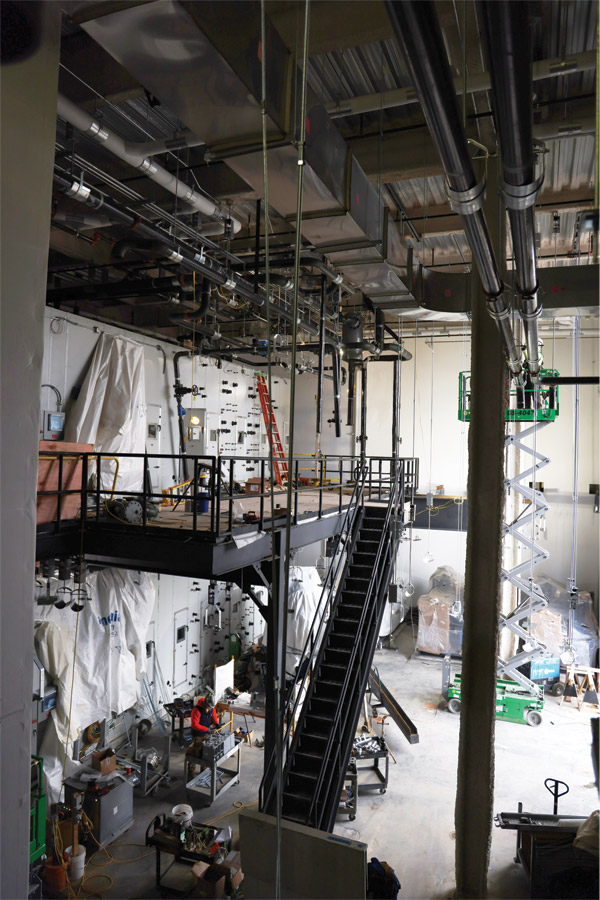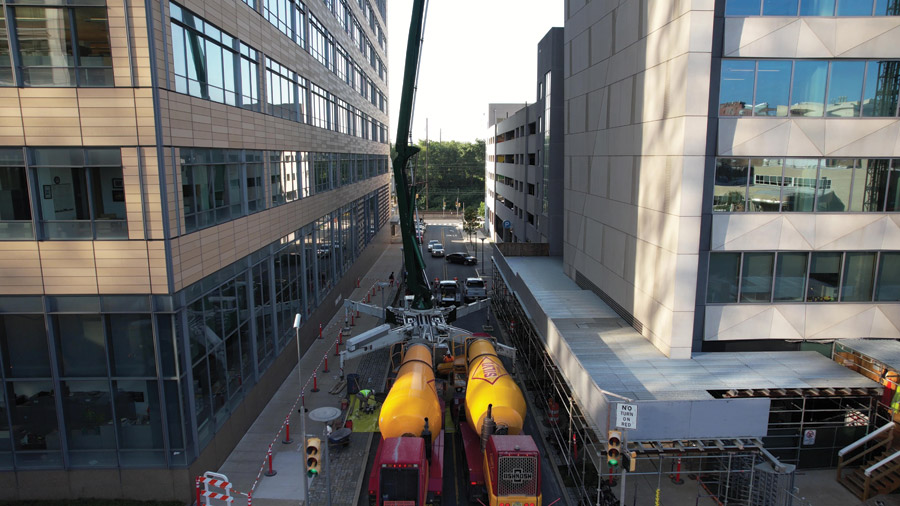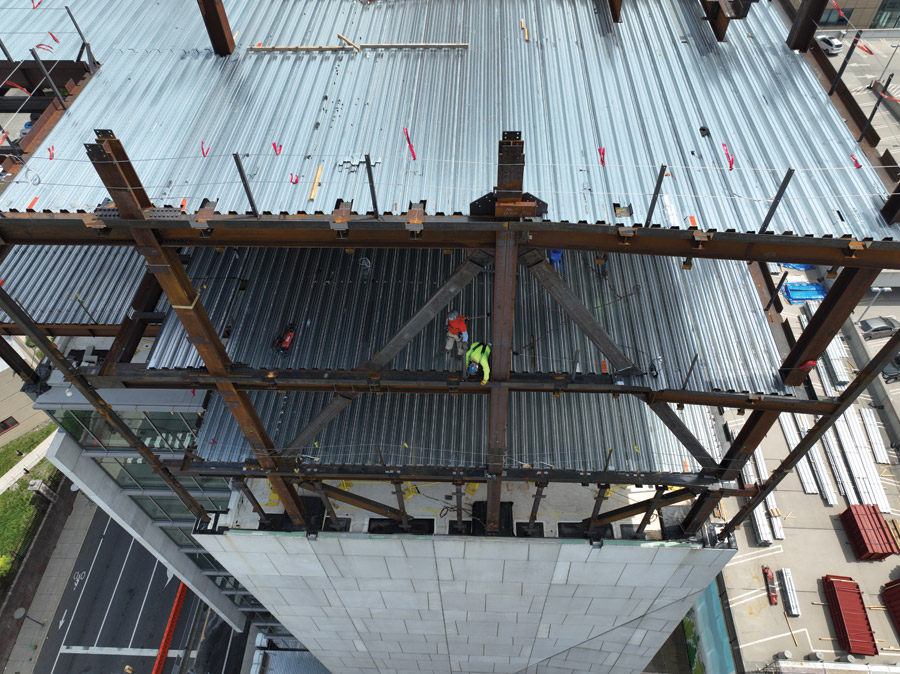Vertical expansion was always in the cards for the University of Pennsylvania Health System corporate office and support services building in West Philadelphia. Completed in 2019, the 10-story, 250,000-sq-ft structure was designed for an eventual overbuild of a similar size. That envisioned addition originally was intended to house administrative staff.
But in the world of medicine, change can sweep in dramatically. The university health care system, nicknamed Penn Medicine, is a case in point. It played a key role in research that led to the rapid development of COVID-19 vaccines. That fast-arising effort also reshaped the priorities and timeline for the envisioned 3600 Civic Center Boulevard expansion.
Stephen Greulich, Penn Medicine associate vice president for capital projects, explains that with an urgent need for more research and laboratory space, “we looked at how we could change plans and accommodate that.”

The project team had to keep existing roof equipment online while building eight stories on top of it and then transition to the new mechanical equipment so they could backfeed and demo the old rooftop equipment and turn that area into laboratory space.
Photo courtesy of LF Driscoll
The key to expediting the overbuild, he adds, would be adopting a “light” version of integrated project delivery. Penn Medicine teamed with Perkins&Will, the original headquarters architect, and with contractor LF Driscoll Co. in 2022 to launch planning for the $360-million, 217,000-sq-ft overbuild comprising eight floors. Officials had an eye toward completing design and construction within three years while keeping the existing building occupied and fully functional.
Greulich explains that the “IPD light” approach afforded the collaboration necessary to fast-track the project while minimizing up-front development time. Because both firms were well-versed in Penn Medicine projects and preferences, “we put together a great team that we had a lot of confidence in, with no need for a learning curve,” he adds.
Chris McGinnis, LF Driscoll project manager, agrees. His company, which had just completed Penn Medicine’s 1.5-million-sq-ft Pavilion, a 17-floor hospital, says that “everyone on the design and construction side was on board with the approach, although it was very fast-paced.”
The ability for some of that project’s key trades to transition to the overbuild assignment helped the team quickly address industry supply chain issues. That enabled team members to make important decisions so that construction could begin by early 2023, including ordering switchgear well before the overbuild was designed because the wait time was 60 weeks, McGinnis says. “We ordered steel on a very basic schematic drawing set, as it would take nine months to get it on site,” he adds.
Allan Horton, Perkins&Will senior project manager, adds that early subcontractor input, constructibility reviews and descoping sessions helped the team press ahead and stay in sync. “If a change came up, we knew about it and communicated it right away,” he says.

Transitioning existing mechanical systems to equipment located in the new mechanical penthouse involved nearly a year of planning to develop and coordinate an intricate step-by-step changeover strategy, currently scheduled to take place in mid-May.
Photo courtesy of LF Driscoll
From Offices to Labs
Although the existing building’s structural and building systems provided a literal and figurative foundation for the overbuild’s design, the program shift from offices to wet labs and support spaces required multiple changes. The need for at least another 4 ft in floor-to-floor heights had a ripple effect on everything from structural loading and occupancy calculations to maintaining continuity of the building’s exterior appearance.
Likewise, floor layouts required rethinking to fit within extensions of the existing building’s core and shaft elements. “We did some adjustments to make it work while also maintaining flow and adjacency between lab floors support areas and researchers’ work spaces,” says Maha Sabra, Perkins&Will managing principal. “It was also important to arrange spaces to provide access to daylight wherever possible.”
“There were very few cranes on the planet that would allow us to do those things without having to be tied into the existing building.”
—Chris McGinnis, Project Manager, LF Driscoll
The design team also was challenged to incorporate other research-oriented elements, including a new top-floor vivarium that would be equipped with a separate ventilation system. To foster all-important collaboration, open lab spaces were arranged to facilitate use by multiple departments.
To encourage scientists to intermingle with colleagues who work on different levels of the facility, Perkins&Will’s design plan calls for one staircase to serve as “a site of exchange, a place where discussions can occur [and] ideas may be shared in passing.”
Horton says that while the overbuild’s design details sought to improve on those of the existing building phase, the design team had to be sensitive to perceptions of equitability between the two phases as well as access to the virtually landlocked existing building and adjacent parking garage.
“Obviously, we want to make a better building, but also find a ‘sweet spot’ to create improvements while keeping features of both phases in balance,” he explains.
Planning for construction activities proved equally challenging, especially given the need to preserve uninterrupted pedestrian and vehicular access to the existing structure. McGinnis says a month of analysis was required to select a Liebherr 630 tower crane for the project because its boom could free-span the rectangular building while also hoisting 20,000-lb precast facade panels several hundred ft above ground.

Working in a dense urban environment made logistics tight, especially given the need to preserve uninterrupted pedestrian and vehicular access to the existing building.
Photo courtesy of LF Driscoll
“There were very few cranes on the planet that would allow us to do those things without having to be tied into the existing building,” he says.
After securing permission to site the crane in a section of an adjacent street right-of-way, the project team developed an 8-ft-thick mat foundation supported by 12 micropiles as much as 120 ft deep. With little laydown room, the detailed logistics plan called for daily just-in-time deliveries of steel and other large components, which were staged at a drop lot approximately a mile away.
Even as the overbuild’s floors took shape, no more than two weeks’ worth of smaller materials were allowed on the site at a time. “We didn’t want floors to be clogged,” McGinnis explains. “Everything had to be on wheels.”
Perhaps the most important construction-phase consideration was keeping the existing building safe and fully operational. Critical issues included the existing 10th floor’s highly sensitive pharmaceutical clean room space and multiple -80°C experiment freezers as well as protecting rooftop generators, air handlers and energy recovery units.
Of particular concern was mitigating water infiltration into the existing columns as the new overbuild took shape. LF Driscoll built a waterproof “box” around each area with a removable lid that allowed access to the top of columns as needed. The steel columns were fabricated with watertight sloped plates within the flanges, essentially waterproofing each unit as it was installed. Welds were inspected daily to verify no leakage was occurring.

Due to the nine-month lead time, the team ordered steel based on a basic schematic drawing in order to get material to the site in time to start the project in early 2023.
Photo courtesy of LF Driscoll
Transition Strategies
LF Driscoll topped out steel erection in July 2023, followed closely by floor slab pours, roof construction and installation of precast and glass exterior elements. The project reached 50% completion in January, marking the start of what McGinnis says is the key to the entire overbuild: transitioning existing mechanical systems to equipment located in a new mechanical penthouse. He adds that the project team has invested nearly a year of planning with building facility managers to develop and coordinate an intricate, step-by-step changeover strategy, which at ENR Midatlantic press time was scheduled to take place during a weekend in mid-May.
“We identified all equipment and everything about it—where it’s located, what it feeds, where it sits electrically, what it does, what alarms it ties to, what department it communicates to,” McGinnis says. “We feel like we have a pretty good plan to keep things running.”
Once the changeover is complete, the remaining mechanical equipment will be demolished and the roof converted into the building’s new 11th floor, housing lab space and a conference center.
“We put together a great team that we had a lot of confidence in, with no need for a learning curve.”
—Stephen Greulich, Associate Vice President for Capital Projects, Penn Medicine
On track for completion in March 2025, the overbuild aims for LEED Gold certification through a combination of locally sourced recycled content, low-VOC materials, water efficiency, a green roof and optimized energy performance. The site constraints proved beneficial to LF Driscoll’s onsite debris management and recycling efforts, with the use of portable wheeled carts that a disposal contractor picks up each day for sorting.
Perkins&Will’s Sabra notes that the overbuild’s lab spaces are “future-proofed” to accommodate changes in use and research equipment. While some spaces are configured for highly specialized activity, others can support a wider range of uses and research pursuits. The conference center also can be configured as a single space or as multiple smaller rooms of various sizes.
“The building systems infrastructure is also flexible enough for any kind of seating arrangement and A/V system,” she adds.
Greulich is pleased with how Penn Medicine’s first integrated project delivery experience has worked, but he says any delivery method that fosters early involvement of subcontractors will produce benefits. “Just getting them working with the design team early—that’s the biggest thing,” he says.
McGinnis agrees. He says the project could not have proceeded without real-time collaboration and team expectation of prompt response to questions and issues. “If it is a design issue, we don’t just pawn it off to the design team to figure it out; we work together to solve the problem with the best solution for the client,” he says. “The same holds true with a constructibility issue. Everyone understands the big picture and the importance of getting this potential life-saving research facility operational as soon as possible.”



Post a comment to this article
Report Abusive Comment